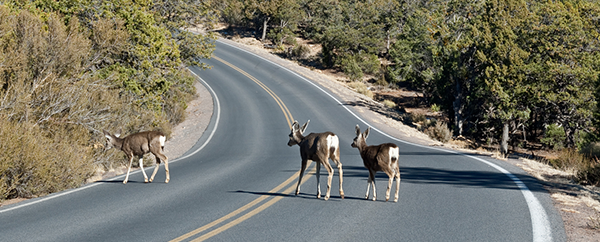Watch out for deer on the road this fall
- Each year there are approximately 1.5 million deer and car collisions, with total costs reaching as high as $1 billion.
- Deer and car collisions are at their peak in the fall, during rutting season.
- Learn steps to take to prevent a road incident with a wandering deer.
If you live in a rural area or plan on taking a drive through the countryside to admire fall colors, be on the lookout for deer. Statistics show that insurance claims for deer and car collisions are much higher in the autumn season, during rut. According to State Farm, there were estimated to be almost two million animal collision claims last year, most of which occurred between October and November during mating season. On average, the cost of claims for November was $3,685 per claim, per the HLDI. This was up from an average claim cost of $2,890 in February.
The National Highway Safety Administration estimates there are approximately 1.5 million deer and car collisions annually, with costs reaching as high as $1 billion in damages. Many of these accidents can result in serious injury and even fatalities.
Related: How to combat the rising cost of vehicle crashes
So, what can you do to help prevent them? Follow these safety tips to navigate deer and car hazards.
- Be aware. Look out for deer-crossing signs and wooded areas where animals are likely to travel. If you travel the same route to and from work every day, you may find deer consistently grazing in the same fields. Make a mental note of when and where you regularly see the animals.
- Be alert. Watch for deer especially around dawn and between the hours of 6 p.m. and 9 p.m., when they’re most active. If you see an animal on the side of the road, slow down. At night when traffic permits, put on your high beams for improved visibility. The higher light will better illuminate the eyes of deer on or near the roadway.
Related: Distracted driving and your insurance client’s employees
- Always wear your seat belt. Most people injured in car-deer crashes were not wearing their seat belt.
- Brake, don’t swerve. Swerving to avoid an animal can put you at risk for hitting another vehicle or losing control of your car. It can also confuse the animal as to which way to go. Instead, just slow down as quickly and safely as you can. Your odds for surviving an accident are better when hitting an animal than when hitting another car.
- Be especially attentive during peak deer hours. From sunset to midnight and during the hours shortly before and after sunrise are the highest risk times for deer-vehicle collisions.
- Be on the lookout for more. Know that deer seldom run alone. If you see one deer, others may be nearby. “Where there’s one, there are usually more” often holds true.
- Slow down and blow your horn. One long blast will go a long way to help frighten the deer away.
- Brake firmly but stay in your lane. Many serious crashes occur when drivers swerve to avoid a deer and hit another vehicle or lose control of their cars.
- If your vehicle strikes a deer, do not touch the animal. A frightened and wounded deer can hurt you or further injure itself. The best procedure is to get your car off the road, if possible, and call the police.
- In the event you experience a deer and car collision, contact your insurance agent or company representative to report the incident.
Related: Fall road hazards for your auto insureds
Sources:
How to Avoid Collisions With Deer This Fall
Avoid a deer-car collision
This blogpost was originally published on our Tribal blog. It has been updated and modified to better fit the needs of Arrowhead’s producers and their clients.

